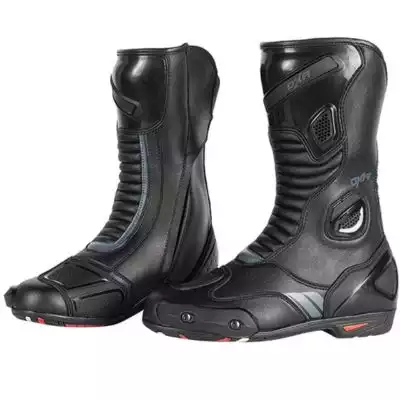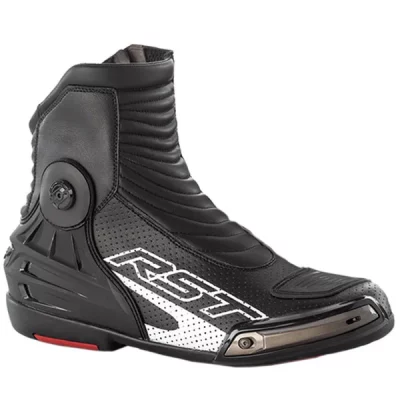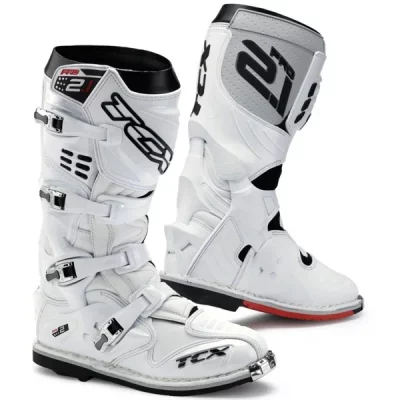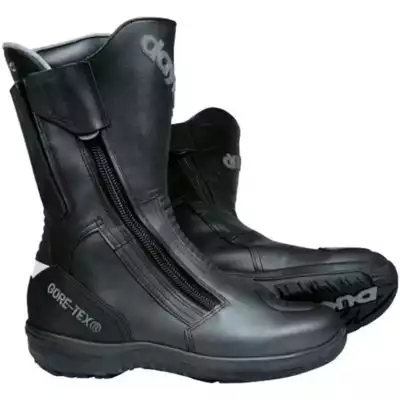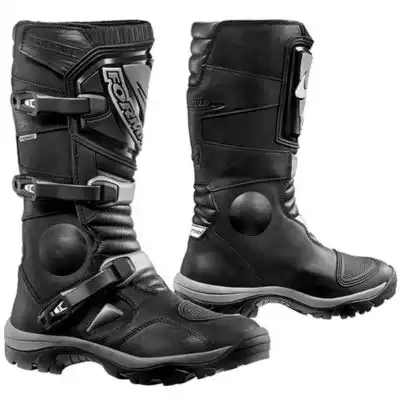I paid £30 for my first pair of motorcycle boots. They got me through my test, and I actually did a couple of weekend tours in those boots. However, they definitely weren’t the best option, more of an afterthought when I first bought all my kit.
Hindsight is a wonderful thing and now that I know better, I do better. Motorcycle boots have the very important job of protecting your feet and ankles, so they should be as carefully selected as any other protective gear.
Luckily for you, we’ve put this guide together to help you find the perfect motorcycle boots, but basically, the right boots come down to a few important factors:
- Budget
- Protection
- Fit
- Style
- Type
- Features
Save Money On Your Motorcycle Insurance
- You could pay less than £195*
- Compare quotes from 25+ UK providers
- Fill in one form to compare top bike insurers
Budget
Your budget will play a role in the boots you look at — it’s unavoidable. Fortunately, there are options across the price range to meet any rider’s needs.
Don’t be fooled into thinking that any tough boots will do and that you don’t need to buy actual bike boots. Timberlands or Doc Martens just won’t cut it in an accident, so leave them at home.
Most motorcycle boots can start from around £50 and go all the way to over £600.
Certain features (like extra armour or a waterproof membrane) will make one pair of boots more expensive than others but I promise a cheap pair of £50 riding boots are still going to be more effective than your £150 trainers.
Protection
The whole purpose of buying a pair of bike boots is to ensure you get the right protection, and a few things can help you identify just how protective your boots are.
CE Rating
A few years ago, the European Union decided that motorcycle clothing should be considered personal protective equipment (PPE) and, as such, should be tested and certified.
Despite no longer being part of the EU, we still use the standards laid out to certify our motorcycle clothing, which consists of trousers, jackets, helmets, gloves, and boots.
For motorcycle boots, two possible test standards can apply: EN 13634:2015 and EN 13634:2017. For each test, your boots will earn either a basic pass — a score of 1 — or a superior pass — indicated by a 2.
The main difference between the two standards is the parameters of the tests. Three areas are tested in the 2015 standard and four areas in the 2017. The rating system on a label would look something like 1-1-1-1, 2-2-2-2, or a combination of ones and twos, obviously with three digits instead of four for the 2015 standard.
The additional area tested under the 2017 standard is the length of the boot. A short boot would receive a 1 and a shin-high/full boot a 2. The height of the boot is indicated by the first digit.
After that, the 2015 and 2017 standards represent the same test criteria:
- Abrasion resistance: how well boots hold up in a slide
- Impact cut: how easily a sharp blade can penetrate through the material
- Transverse rigidity: how well the boot prevents your foot from being crushed if the bike drops on it
In addition to the numerical ratings for each of the tests, you may also see the following:
- IPA: impact protection ankle
- IPS: impact protection shin
- WP: waterproof ability
Looking at the CE ratings and information on the labels will give you a good starting point for knowing how protective a particular pair of boots are. However, aside from that there are some key things to look for in a pair of protective bike boots.
Basic Protection
- Moulded ankle protection
- Anti-slip soles with excellent grip
- Good torsional stiffness with a limited range of movement
- Tough, abrasion-resistant construction
- Proper fit
Superior Protection
- Shin/toe/heel armour
- Toe sliders
- Steel shaft in the sole
- Thicker sole
Generally, the more protection a pair of boots offers, the better. Of course, the level of protection you require will depend on your riding style and needs.
If you’re riding off-road, you need the most protection possible from a full-length, fully armoured boot, but this could be overkill if you’re just commuting a five-mile ride at slower speeds through town everyday.
Fit
It is super important that the boots you choose fit you properly. You need to be comfortable on the bike so you can control it well but also off it when walking around.
The boots you pick should be snug, supporting your feet from every angle. There should be no pressure points or pinching, and, equally, they shouldn’t be loose anywhere. Loose boots can come off in an accident, which would render them useless, but they can also just rub your feet, causing discomfort.
You should be able to feel the armour in place, and it should be sat in the right place so it can do its job properly.
Boots can be notoriously difficult to get on and off, but despite the extra faff, you need to be sure you can do them up properly, whether they have laces, velcro, zips, or all three. If a long boot feels good on the foot but doesn’t do up around the calf properly, they’re no good and you need to find a different pair.
You should also be cautious about choosing a pair of boots for comfort alone. For example, short trainer-style riding boots aren’t appropriate for high-speed sports riding.
If you find a pair of boots that are super comfortable for walking around in and they feel like a regular pair of boots/trainers, then you need to be extra sure they offer an adequate amount of protection for your riding needs.
Style
There are four main styles of bike boots:
- Short boots
- Long boots
- Extra-long (off-road) boots
- Trainer-style boots
Long boots, such as the DXR Code Evo Boots, are the most traditional style of boot. Look for race and touring boots, which tend to be long boots and will offer a substantial amount of protection.
Short boots, like the RST Tractech Evo 3 CE Short Boots, are often just shorter versions of the flagship long boot. These are a great option for those who still value protection but struggle with the fit of a longer boot.
Off-road boots are usually longer than other boots to offer the most protection possible. Off-road riding carries its own risks and the rider is more likely to come off the bike, drop the bike, and encounter obstructions that could cause harm, which is why good protective boots, like TCX Pro 2.1 Boots, are essential.
Then you can find trainer-style short boots, such as the Alpinestars J-6 Waterproof Shoes, which have significantly less protection but might be suitable for slow speeds around town.
Type
Within the four main styles of boots, there are several types of boots to choose from, with each type fulfilling a different purpose.
- Winter
- Summer
- Sports
- Adventure
- Touring
- Waterproof
- Off-road
- Casual
Many riders, including me, often end up with more than one pair of boots, although some touring boots, like the Daytona Road Star Boots, could serve you as well as a Swiss army knife — one tool for all your needs.
Touring boots tend to be waterproof, durable and have plenty of adjustability, prioritising comfort. Aside from being the obvious choice for those undertaking long-distance tours, touring boots are also an awesome option for those who ride all day, every day, in all weather, such as police riders or riding instructors.
Sports boots, such as the RST Tractech Evo 3 Boots, offer excellent protection as they are built for the track where high speed incidents are a risk. You can also find track-style boots, like the Richa Blade Boots, with useful features, like a waterproof membrane, that make them also suitable for sports-bike road riders.
Adventure boots are another great choice when protection is a priority. They combine off-road protective properties with the comfort of a regular road boot. A brilliant choice would be the Forma Adventure Boots, which also come in a Low Boot version.
Casual boots, often a trainer-style short boot like the Richa Krazy Horse Boots, are a solid option for riders who mainly do shorter journeys at slower speeds. They are good for city commuters who don’t want to carry a pair of shoes with them, or summer riders who want to jump off their bike at an ice cream shop and go for a walk.
To give you an idea of where to start, check out a roundup of our favourite motorcycle boots across all the different types and styles.
Features
Motorcycle boots don’t offer an abundance of features, but there are some that will help you choose whether a particular pair is a good fit for you.
Waterproof Material
For some people, boots being waterproof is an essential requirement. If that’s you, go for Gore-Tex. Gore-Tex is a waterproof material that not only keeps your feet dry but also lets them breathe. To read more about Gore-Tex and why we rate it so much, check the buying guide in our piece about Gore-Tex jackets.
Pro tip: Ride with your trousers over the tops of your boots. Even the best waterproof boots can let in water through the leg opening!
Adjustability
Boots with a bit of adjustability will ensure you stay comfortable. Some boots will have adjustable velcro panels that you can tighten or loosen to suit, and others have ratchet straps that you can adjust to your preference.
Boots that have some adjustability in them are great for riders who struggle to find boots that fit around their calves. For some reason, a lot of European manufacturers make their boots super narrow in that area, and it can be difficult to get the right fit.
Ventilation
Ventilation is an underrated feature in motorcycle boots. If you ride in hot weather, a mesh insert or vents can be a true blessing. Vents will help keep your feet cool and allow them to breathe.
Easy Fit and Closure System
Boots can be difficult to pull on and get off, so some manufacturers have addressed this by making them easier to get on and do up. Some boots have laces that stay laced up, but a side zip secures the boots in place while making them easier to get on and off.
Boots like this will be good for those who have mobility issues. I struggle with my boots because I have a bad knee and back, so the easier they are to get on and do up securely, the better.
Choosing Your Boots
In order to establish exactly what kind of boots you need, ask yourself these questions:
- What is your riding style?
- What type of bike do you ride?
- What weather do you ride in?
- Will you ride in the winter as well as the summer?
- Will you do a lot of walking around off the bike?
By answering these questions, you can then further narrow your choices down by looking at styles, types and features of bike boots.
If you commute throughout the winter and in the wet, it’s pretty essential to have waterproof boots. If you only ride in good weather but find yourself green-laning as well as road riding, you might consider a pair of adventure boots for the extra protective properties. If you do a lot of track days, then protective race boots are going to be the way forward.

